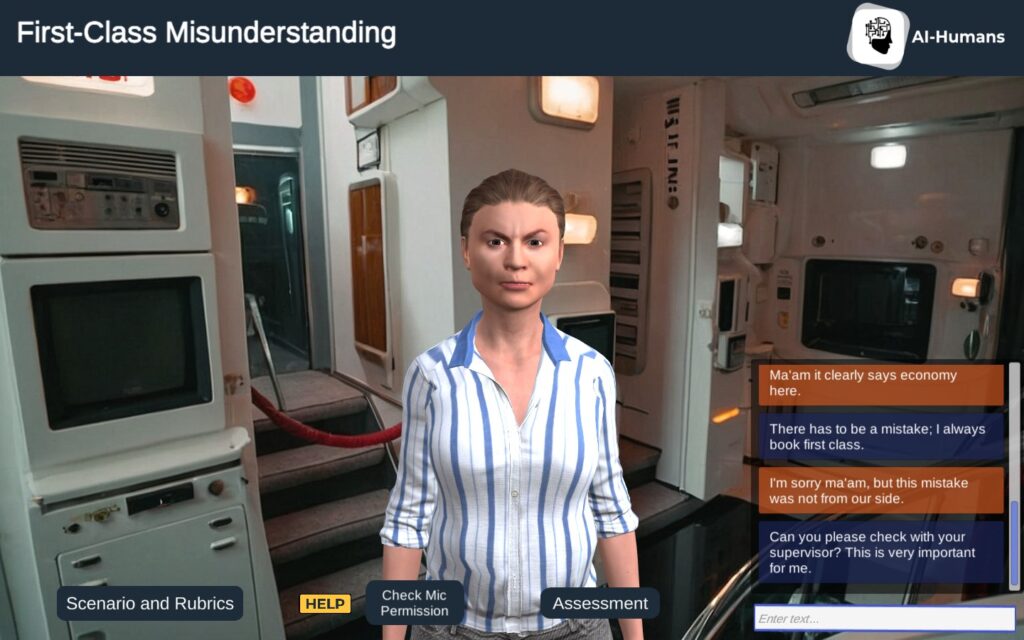A delayed flight, a squabble over seating, missing luggage, bad weather conditions, unruly passengers . . . etc., etc. The situations in which aviation professionals find themselves trying to handle and resolve passenger issues are numerous. A small misstep or a little bit of insensitivity leads to issues spiraling out of control and attracts negative publicity, eventually hitting the company hard and bad. All this can be avoided by maintaining a crew adept in soft skills, starting from the ground staff to the pilots. No doubt they are all skilled in their field of operation, but soft skills are equally important, especially when it comes to interacting and communicating with passengers. The tried and tested way to develop and refine these skills is through practice because there is no formal education when it comes to learning them. Practicing on the job is one of the ways to do it, but what if we can give professionals the opportunity to be prepared before they step into their roles? What if there is a way to train for soft skills? Well, this is very much possible and can be achieved with the use of virtual scenarios powered by conversational AI. Integrating conversational AI in aviation training like the ones offered by AI-Humans provides learners realistic practice opportunities that helps them start their jobs with proficiency in real-world skills.
How does AI-Humans help in aviation training
Aviation is not just about flying aircrafts and ferrying passengers from one place to another. In between the two lies a range of other activities upon which the success of its primary task lies. Training with AI-Humans scenarios provides benefits in multiple ways helping learners be better prepared to handle real world challenges.
Realism – Training and practicing in realistic environments provide the much-needed practical experience to develop skills like problem-solving, critical thinking, effective communication, thinking upon one’s feet, team spirit, leadership, to name a few. At the heart of everything is human interaction. It could be between the pilot and their crew, between the flight crew and the passengers, between the pilot and the ground staff, and a range of other interactions. In such a scenario, the significance of realism in a training environment cannot be emphasized enough. These interactions can be handled with expertise only when a professional gets to practice them in realistic environments. For example, how does one handle a passenger who is upset about not being assigned a business-class seat?
Real-time detailed feedback – Feedback is essential in every training scenario. It enhances the effectiveness of the training and provides better learning opportunities. However, equally important is timely feedback. Delayed feedback may lose its effectiveness leaving key issues to go unaddressed. With AI powered scenarios from AI-Humans, the feedback is not just timely, it is in real-time and a detailed analysis of the user’s performance. The user can instantly identify the areas of improvement and work upon them. This feedback is visible to trainers as well, helping them get better insight into the performance of every user.
Accessible and scalable – Easily accessible and highly scalable, two significant benefits of the AI-Humans training solutions. Training cases created on the platform can be accessed on a PC in any web browser. No special software is required to experience the training scenario. A single case can be viewed and experienced by multiple people, across geographies at the same given time. This not only makes it scalable but also brings about uniformity and consistency in training. Training a large number of professionals can be time-consuming and resource intensive. With the AI-Humans training content, both these issues are taken care of, providing quality training to professionals anytime, anywhere.
Unique learning experience – Since the sessions are AI-powered, the experience is unique for every user. The course a conversation takes is dependent upon how the user steers it. Depending upon how the user interacts with the virtual character, the AI-powered character will respond, and it is highly unlikely that two users will have an identical conversation. This unique experience prepares the user for those unique cases they may come across in a real-world scenario and helps them be in a better position to face them. When a passenger approaches requesting a wheelchair for their son, the help desk’s executive can react and respond in multiple ways
Safe learning environment – When the weather is bad mid-flight, or there is an unruly passenger on board, how does a flight attendant handle the situation? The former will require them to be calm and patient and present a reassuring and comforting attitude so that passengers do not panic. In the latter case, the same flight attendant will have to portray a confident and stern approach to get the matter under control. These are skills that do not come easily and practicing them on the job may carry their share of risk. However, being able practice in safe and controlled virtual spaces provides realistic training that can be replicated in the real world.
It is true that training is imperative for entry level employees, but with these AI-powered scenarios experienced professionals can benefit from continuous training programs. A thing like practicing emergency training procedure can be practiced multiple times with a virtual character, making it muscle memory for the user.

Who can benefit from AI-Humans scenarios in the aviation industry
Aviation goes beyond the pilot and the cabin crew and involves many other roles that make it possible for every flight to operate smoothly. Each role can benefit from soft skills training scenarios powered by AI.
Pilots – To connect with passengers, apart from the usual announcement they make, they may have to handle emergency situations. In such circumstances it matters how they hold themselves together and, at the same time, how they communicate with the passengers and their team. The pilot is the leader of the flight and must possess excellent leadership skills.
Cabin crew – This group of individuals are required to interact with passengers a great deal. Interacting with different kinds of passengers and trying to resolve varied problems can help them practice rare but possible circumstances and be prepared for all eventualities.
Ground staff – Coordination and communication are important on their part. When faced with an operations issue, how do they handle the situation and provide uninterrupted services? Only practice can help them achieve that level of perfection.
Customer service agents – It could be a request to cancel a ticket, or to change travel dates, a lost luggage, a special request for the elderly, etc. etc. In short, the kinds of requests a customer service agent may have to handle are varied but the need is to be prepared to handle each call with professionalism and to the customer’s satisfaction. Practicing with different scenarios can expose learners to different kinds of calls they may receive and provide them with practice in handling each one.
Apart from these roles there are the aviation medical staff, the airport security staff, the flight dispatchers, air traffic controllers and the maintenance staff, each one serving an important function as an individual and as a part of the team. Perfect coordination, collaboration and communication is required among all these groups to guarantee smooth and satisfactory service. Training in virtual scenarios with virtual characters provides them with the perfect ground to enact and practice different types of situations they may come across at their job.
In the Sixth ICAO Global Aviation Training and TRAINAIR PLUS Symposium, ICAO’s Deputy Director for Technical Co-operation and Training Mr. Meshesha Belayneh emphasized upon the “need to develop and deliver innovative and high-quality solutions and learner-centred pedagogy for aviation training professionals.” Implementing conversational AI in training is one of the best ways to achieve this as the training is created to cater to learners and each learner derives a personal experience from the session.
AI-Humans is a SaaS-based platform that enables trainers to develop AI-powered durable skills training solutions within minutes. While all technical aspects of creating these AI-powered scenarios have been taken care of by the team, trainers can devote all their attention towards giving shape to highly effective and relevant training and provide learners with engaging and immersive training opportunities. Practicing durable skills is the best way to learn and this is precisely what AI-Humans is providing.

